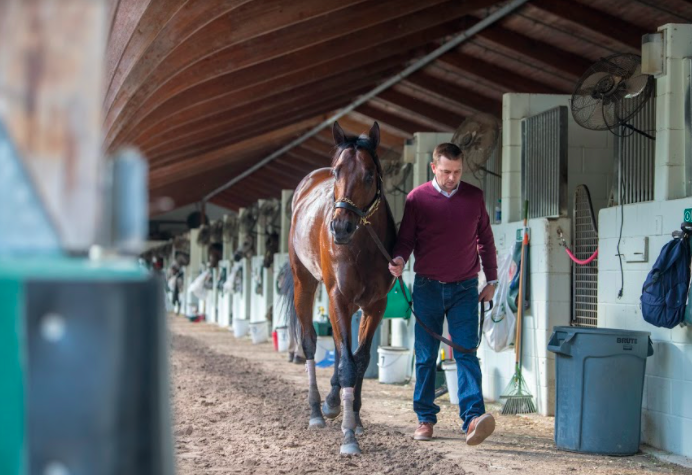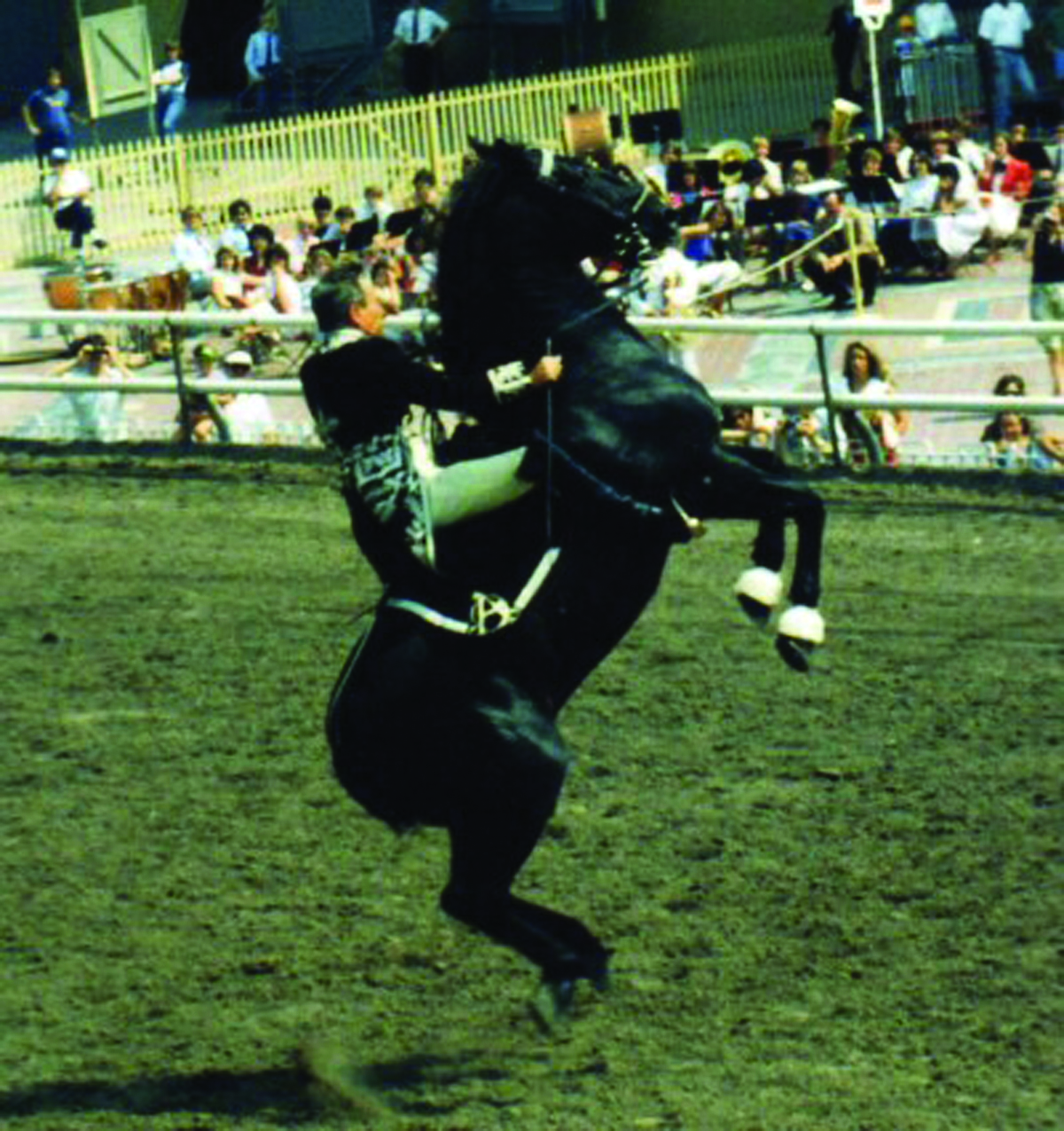From the ground up - Preakness Stakes winning trainer Michael McCarthy worked his way into the training ranks, forming a solid foundation of success along the way.
/By Annie Lambert
Trainer Michael McCarthy felt an immediate connection to the racing industry after attending the races with a few high school buddies. Following graduation, he found his way to the backside, working a variety of jobs while attending college at night. His most prominent employment was spending more than a decade as assistant to Todd Pletcher, a seven-time Eclipse Award winning Trainer of the Year.
McCarthy, now 50, attained his trainer’s license in 2006 and began training his own stable of horses in 2014. Since then, the Southern California-based horseman has saddled 1,063 starters with 174 wins, 138 seconds and 172 thirds, earning $18,083,294—including multiple graded stakes.
Pletcher once called his former protégé “reliable, confident and capable.” McCarthy has also proven himself to be responsible and patient with perseverance.
• Racing intrigue
At the age of six, McCarthy moved to Arcadia, Calif., with his family. The family home was near enough to Santa Anita to hear the races being called. Although McCarthy’s parents were not horse racing enthusiasts, he became smitten by the industry. His father, a high-end office furniture dealer (now semi- retired), was always a big sports fan—“a basketball, football kind of guy,” who was not initially into racing but now closely follows his son’s career. Young McCarthy’s first job at Santa Anita was working for trainer John O’Hara. He was at the track during the day and attending his freshman year at Cal Poly Pomona with night classes in animal husbandry. He also worked for veterinarian Dr. Wade Byrd and got handy with a stopwatch with help from Santa Anita clocker Gary Young.
Michael with Proud Accolade at Hollywood Park, 2004.
In about 1994, McCarthy had the opportunity to spend four months at a training center in Japan as well as several months at The National Stud in England. He worked as an intern in a variety of jobs, including breeding to training aspects of the racing business. While still in college, McCarthy soaked up experience working for trainer Doug Peterson and was an assistant at Santa Anita for Ben Cecil.
• Upward mobility
Working for Cecil was his final job prior to heading east to work for Todd Pletcher. Jockey agent Ron Anderson negotiated a meeting between McCarthy and Pletcher, who was looking for an assistant trainer to replace George Weaver who was leaving to start his own public stable. After some phone calls back and forth, McCarthy headed to Belmont Park in July of 2002 for an introduction of sorts. He began his new job on August 25, 2002—a date he has no trouble recalling.
Michael with Friendly Island after winning the Palos Verdes Handicap at Santa Anita Park, 2007.
“Moving east was certainly an adjustment period,” McCarthy admitted. “But when you’re young and single, it’s easy to do.” There was a learning curve going to work in an expansive stable like Pletcher’s—a fast-moving organization with many horses and a lot of moving parts. McCarthy quickly caught up to speed, and by November of that year, he found himself traveling to Hong Kong with Texas Glitter.
Texas Glitter was a six-year-old when he headed to Southeast Asia with McCarthy. Their first stop was at California’s Hollywood Park, where the son of Glitterman won the Gr3 Hollywood Turf Express Handicap. Sixteen days later, the multiple graded stakes winner found no luck in the Gp1 Hong Kong Sprint at Sha Tin— the final race of his career. …
CLICK HERE to return to issue contents or sign up below to read this article in full
BUY THIS ISSUE IN PRINT OR DOWNLOAD
ISSUE 60 (PRINT)
$6.95
ISSUE (DIGITAL)
$3.99
WHY NOT SUBSCRIBE?
DON'T MISS OUT AND SUBSCRIBE TO RECEIVE THE NEXT FOUR ISSUES!
Four issue subscription - ONLY $24.95






![“On, no,” you’re saying to yourself, “not more politics!”But stop and think: American racing is and has been since the 1930s essentially political, since it’s a state-regulated industry. It’s about to add another layer of government regulation, now that in their mutual wisdom The Jockey Club, United States Congress, and former President of the United States have just enacted new legislation to elaborate racing regulation still further. And complicate it?The last time I wrote about subjects I’m going to raise again here, I was accused by one of our most prominent readers of being a “socialist,” and that sprang to mind when I was assailed the same way very recently by another prominent personage. I know that one of them is a strong supporter of the new “Horseracing Integrity and Safety Act,” or HISA.My former students at Harvard College would get a serious jolt out of that accusation; they used to call the classes in Government I taught “Firing Line,” after William F. Buckley’s right-wing conservative television program of the day. I once read aloud to them paragraphs from a Lincoln Day speech delivered by a prominent politician, and largely written by one of my academic mentors who had been showered in infamy for his work with Barry Goldwater. I didn’t tell them that, of course. And then I asked them who they believed delivered those ringing sentiments.“JFK,” came shouted back. “FDR. Justice [Hugo] Black. Justice Douglas.” Liberal lions all. Then I read another famous line from the same speech, about the “nattering nabobs of negativism,” and they all realized the parts of the speech they loved had also been delivered by one Spiro T. Agnew, former Vice President of the United States. Labels, like stereotypes, are diversions from objective analysis. As we assess what ails our sport, and ideas to improve it, labeling a person or an idea “socialist” (or anything else) is just plain counterproductive. We have to confront objective reality and consider all possible corrective means.A hundred years ago – when this really was the Sport of Kings -- it relied then as it still does now on all the commoners. Both kings and commoners love to bet, but there are way more of the latter than the former, and now a great many owners are commoners, too. Back then, virtually everyone recognized that a sport so afflicted with temptations to dishonesty and corruption needed serious governmental oversight if it was to survive and prosper. Yet our racing forefathers were hardly “socialists”! So were born pari-mutuel wagering, the totalizator, and testing for forbidden substances, among countless rules across dozens of American states to build and retain public confidence in the integrity of our sport. Does such government intrusion and oversight smack of “socialism”? To some or many, yes. And they bring with them their own problems of potential misconduct and unfairness in administration. Whether king or commoner, whether citizen or government official, we all share one thing: human nature.](https://images.squarespace-cdn.com/content/v1/517636f8e4b0cb4f8c8697ba/1614067756732-WVVFHYY68RO0IB43Z9OE/Adam+Smith+-+author+of+_The+Theory+of+Moral+Sentiments_.png)




















